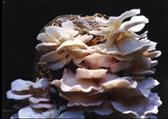 |
|||||||||||||||||||||||||||||||||||||||||||||||
| Organic Farming :: Compost | |||||||||||||||||||||||||||||||||||||||||||||||
Coir Compost 2. Coir pith composting technology 3. Nutritive value of raw and composted coir pith compost 4. Benefits of composted coir pith 5. Application of coir pith compost 6. Limitation in using composted coir pith The largest by products of coconut is coconut husk from which coir fibre is extracted. This extraction process generates a large quantity of dusty material called coir dust or coir pith. Large quantity of coir waste of about 7.5 million tones is available annually form coir industries in India. In Tamil Nadu state alone 5 lakh tons of coir dust is available. Coir pith has gained importance owing to its properties for use as a growth medium in Horticulture. Because of wider carbon and nitrogen ratio and lower biodegradability due to high lignin content, coir pith is still not considered as a good carbon source for use in agriculture. Coir pith is composted to reduce the wider C:N ratio, reduce the lignin and cellulose content and also to increase the manorial value of pith. Composting of coir pith reduces its bulkiness and converts plant nutrients to the available form. 2. Coir pith composting technology Collection of raw material
Site selection for composting
Coir pith is an aerobic composting. So it should be heaped above the soil. There is no need for pit or cement tub to make the compost. Coir pith should be spread to the length of 4 feet and breadth of 3 feet. Initially coir pith should be put up for 3 inch height and thoroughly moistened. After moistening, nitrogenous source material should be added. The nitrogenous source may be in the form of urea or fresh poultry litter. If urea is applied, it is recommended that 5 kg urea is required for one ton of coir pith. This 5 kg equally divided into five portions and in alternative layer of coir pith one kg of urea should be applied. If fresh poultry litter is applied, it is recommended @ 200 kg for one ton of coir pith. One has to proportionally divide and put the required amount of poultry litter over the coir pith. For example if one ton coir pith is divided into 10 portion, in the first layer, 100 kg poultry litter is added. After adding, the nitrogen source, the microbial inoculums Pleurotus and TNAU biomineralizer (2%) are added over the material. Over this one portion of coir pith is added and the same input mentioned above should be added. It is advisable to make a heap up to minimum of 4 feet height. But beyond 5 feet, it requires machinery to handle the materials. The increase in height retains the temperature generated in the coir pith compost process. If the height is low, what ever the heat generated will be dissipated easily. Turing of material The compost heap should be turned once in 10 days to allow the stale air trapped inside the compost material to go out and fresh air will get in. The composting process is an aerobic one, the organism performing the composting require oxygen for its metabolic activity. This turning of material indirectly aerate the substrate. The other way of giving aeration is inserting perforated unused PVC or iron pipe in the composting material both vertically and horizontally. Moisture maintenance Maintaining optimum moisture is the pre-requiste for uniform composting or waste material. Sixty percent moisture is to be maintained 60 % moisture is, the compost material should be always wet. But excess water should not be drained form the waste material is to take a handful of composting material and put in between the palms and squeeze it. If no water is coming out of the material, that moisture status is ideal for composting. Compost maturity The period of composting vary from substrate to substrate. If all the above said conditions are maintained in the composting, it will take sixty days (60 days) for some of the physical parameters to be observed in the compost. First observation is volume reduction of waste material. When the waste material is composted, the compost heap height will be reduced by 30 %. The second observation is waste materials are turned to black in colour and the waste particle size is reduced. The third observation is that composted material emits earthy odour. The chemical observation for compost maturity is to be analysed in the laboratory. The chemical observations are narrower C:N ratio (20:1), less oxygen uptake, less number of microorganism, more amount of available nutrients and highly cation exchange capacity. Compost harvest The composted material which is obtained from sieving is ready for use. If the composition is not used immediately, it should be stored in a open, cool place, to retain the moisture, so that the beneficial micro organism present in the compost will not die. Once in a month, water is sprinkled over the compost material to maintain the moisture. 3. Nutritive value of raw and composted coir pith compost
4. Benefits of composted coir pith
5. Application of coir pith compost
6. Limitation in using composted coir pith
Source Composting technology and organic waste utilization in Agriculture |
|||||||||||||||||||||||||||||||||||||||||||||||
© TNAU 2008 - 2024 All Rights Reserved. |
![coirpith_compost[1]](orgfarm_coircompost_clip_image002.jpg)

